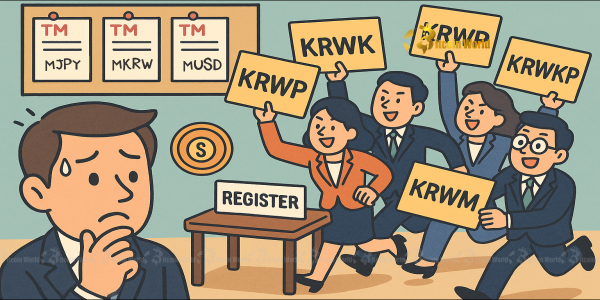


0
0
BitcoinWorld

Bifrost’s Ambitious Leap: Unveiling MJPY, MKRW, and MUSD Stablecoin Trademarks
The cryptocurrency world is buzzing with the latest development from South Korea’s PiLab Technology, the innovative firm behind the L1 cross-chain Bifrost Network. In a move that signals significant strategic intent, PiLab has officially filed trademark applications for a trio of new stablecoins: MJPY, MKRW, and MUSD. This isn’t just a bureaucratic formality; it’s a powerful statement about Bifrost’s expanding ambitions in the global digital asset landscape and its commitment to fostering a more interconnected blockchain ecosystem.
At its core, Bifrost Network is designed to be a universal hub for decentralized applications, aiming to solve the pervasive issue of blockchain fragmentation. As an L1 cross-chain platform, Bifrost facilitates seamless communication and asset transfers between different blockchain networks, creating a more unified and efficient digital economy. The recent trademark filings, reported by the Korea Intellectual Property Rights Information Service (KIPRIS), indicate that PiLab Technology is now laying the groundwork for a new chapter in its development: the integration of national currency-pegged stablecoins directly into its ecosystem.
This strategic step suggests a clear vision for Bifrost to not only connect disparate blockchains but also to bridge the gap between traditional fiat currencies and the decentralized world. By establishing official trademarks for these digital assets, PiLab Technology is taking proactive measures to secure its intellectual property and pave the way for the potential launch and widespread adoption of these new stablecoin offerings.
For those new to the concept, stablecoins are a class of cryptocurrencies designed to minimize price volatility. Unlike Bitcoin or Ethereum, whose values can fluctuate dramatically, stablecoins aim to maintain a stable value, typically by being pegged to a fiat currency like the US Dollar, a commodity like gold, or a basket of assets. This stability makes them incredibly useful for various purposes within the crypto ecosystem and beyond:
The introduction of new stablecoins, especially those pegged to specific national currencies, signifies a maturation of the market. It allows for localized financial services and potentially opens up new corridors for international trade and remittances, making digital finance more accessible and relevant to diverse economies.
The specific choice of MJPY (Japanese Yen), MKRW (Korean Won), and MUSD (US Dollar) stablecoins by PiLab Technology is particularly telling. It highlights a strategic focus on key global economies and financial hubs:
These filings suggest that Bifrost is not just aiming for a single global stablecoin but a multi-currency approach that caters to the specific needs and regulatory landscapes of different regions. This could be a game-changer for cross-border payments, making it easier and cheaper to transfer value between these major economic zones.
Why are these trademark filings so important for Bifrost and the broader crypto space? In the rapidly evolving world of blockchain and digital assets, establishing legal ownership and protection for intellectual property is crucial. Trademarking names like MJPY, MKRW, and MUSD provides several key benefits for PiLab Technology:
This proactive legal strategy demonstrates PiLab’s foresight and dedication to building a sustainable and compliant ecosystem around its stablecoin offerings, setting a precedent for responsible development in the crypto industry.
The move by PiLab Technology has broader implications for the entire blockchain ecosystem. It underscores a growing trend where foundational blockchain networks are expanding their utility beyond just facilitating transactions to becoming comprehensive financial platforms. By integrating stablecoins pegged to major fiat currencies, Bifrost is positioning itself as a crucial infrastructure layer for the future of finance.
Actionable Insights for Users and Developers:
However, challenges remain. Regulatory clarity across multiple jurisdictions is paramount, and competition from existing stablecoin giants and emerging central bank digital currencies (CBDCs) will be fierce. Successful adoption will also depend on robust technological implementation, security, and strong partnerships.
PiLab Technology’s trademark filings for MJPY, MKRW, and MUSD represent more than just legal paperwork; they are a clear indicator of Bifrost Network’s ambitious vision for a globally interconnected and stable digital economy. By focusing on multi-currency stablecoins, Bifrost is setting the stage to become a key player in facilitating seamless cross-border value transfer and localized financial services within the blockchain space. As the crypto landscape continues to evolve, strategic moves like these will be crucial in shaping how we interact with digital assets and integrate them into our everyday financial lives. The journey of MJPY, MKRW, and MUSD will be an exciting one to watch.
To learn more about the latest crypto market trends, explore our article on key developments shaping stablecoin adoption and institutional interest.
This post Bifrost’s Ambitious Leap: Unveiling MJPY, MKRW, and MUSD Stablecoin Trademarks first appeared on BitcoinWorld and is written by Editorial Team
0
0
 Manage all your crypto, NFT and DeFi from one place
Manage all your crypto, NFT and DeFi from one placeSecurely connect the portfolio you’re using to start.